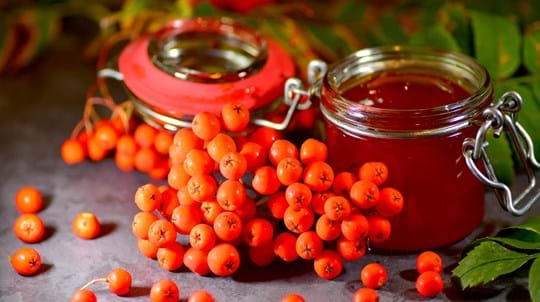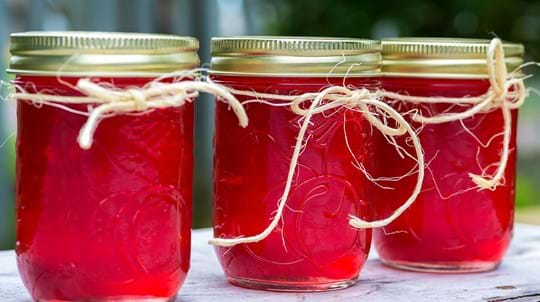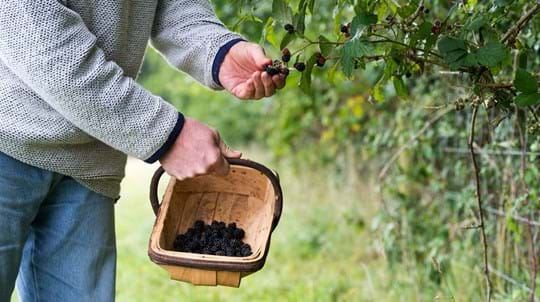Give back to nature
Experiment with your foraged finds in style. Every purchase from our kitchen and dining range helps fund our vital work to plant and protect trees and woods across the UK.
Shop now
Content manager, botanist and tree lover
Go for a walk in September and you’ll find an abundance of edible wild food.
Early autumn is the best time to enjoy foraging. It's when hedgerows and trees are heavy with the jewel-like colours of ripening fruits and nuts.
I think that gathering and eating wild food is one of the best ways to understand and respect nature. But overenthusiastic collecting can put populations of species at risk, so please forage responsibly.
Each beech tree produces a bumper crop of nuts, also known as beech masts, every 4-5 years. When you find them they could be abundant, though squirrels, badgers and birds may have got there first.
How to use it: the nuts make a tasty raw nibble when you’re out and about. Scrape off the outer brown skin to reveal the triangular seed. They can be used in a similar way to pine nuts, sprinkled on salads and risottos. Roast in the oven then place between two tea towels and rub to remove shells. Beech nuts can be slightly toxic if consumed in large quantities due to the tannins and alkaloids.
What to look for: look out for pairs of three-sided nuts in bristly cases from mid-September and throughout October.
The leaves of hawthorn are traditionally known as 'bread and cheese' which usually refers to their very basic culinary qualities. But some people have eaten the berries together with autumnal leaves (they are apparently just about edible) which also gives the name bread and cheese. The leaf is the bread and the berry is the cheese.
How to use it: generally haws are not consumed raw due to the large stone and dry, starchy flesh. They are much better when cooked and go well in jams, jellies, vinegar and ketchup. For a hedgerow tipple try hawthorn schnapps.
What to look for: hawthorn berries are also known as haws. The round fruits are about 1cm long and resemble small apples with a single seed. They are best picked when they’re a deep red and fully ripe.
Rosehips are the red and orange seed pods of rose plants commonly found in hedgerows.
How to use it: the hips have a fleshy covering that contains the hairy seeds. The irritant hairs were traditionally used by schoolboys to make itching powder. The outer layer is packed with vitamin C and they are renowned for helping stave off winter colds. They are good in wines, jellies, jams and can be used to make a delicately flavoured rosehip syrup for cordial or pouring onto ice cream or pancakes.
What to look for: look for bright red rosehips from September to November along hedgerows and woodland fringes. Snip or carefully pull the hips close to the base of each pod (to avoid being attacked by prickly thorns).
The blackthorn is best known for its crop of tart, acidic fruits used to make the deep-red wintry drink, sloe gin.
How to use it: the general rule is to pick after the first frost as it softens the skins and helps to release the juices. You can get round this by picking early and freezing at home instead. Make our sloe gin recipe or try using sloes for whisky, jams and vinegar.
What to look for: the blue-black berries are ready for picking from the end of September to December. In some years, blackthorn trees along hedgerows and fields are heavy with fruit.
You’ve struck gold if you come across a hedgerow full of gleaming red raspberries. Wild raspberry is surprisingly widespread in the UK, though it can be difficult to separate native and cultivated populations that have escaped into the wild.
How to use it: wild raspberries have a sharper flavour than their tamer cousins. You may only find enough for a handful to be appreciated there and then. But if you find enough, you can use them in the same way you’d use shop-bought raspberries. They lend themselves well to sorbets in particular. The young leaves of raspberry plants can be made into herbal teas traditionally used for their medicinal properties.
What to look for: once the fruit is ripe it is difficult to confuse a raspberry with anything other an unripe blackberry. Look for it in open woodland, scrub, heathland and sometimes hedgerows. In the uplands, it grows on the drier ledges of basic crags and ravines, and below base-rich cliffs. Wild raspberries are generally smaller than cultivated varieties.
Our wild native strawberry is not an ancestor of cultivated strawberries. Its fruits are small, often only around 1cm across and its seeds sit on the surface (rather than sunken as in cultivated strawberries).
How to use it: it’s difficult to pick wild strawberries in any kind of quantity. The fragrant, scented flavour of wild strawberry is best savoured on its own. If you manage more than a handful you could add a sprinkling of sugar and cream. The addition of just one or two berries can add powerful flavour to puddings such as crème brûlée or panna cotta.
What to look for: look for the fruits from July onwards in deciduous woodlands and shady scrub on chalky soil. Local populations are often well kept secrets, since over picking and the illegal uprooting of plants for transplanting into gardens can quickly decimate stocks.
Experiment with your foraged finds in style. Every purchase from our kitchen and dining range helps fund our vital work to plant and protect trees and woods across the UK.
Shop now
Blog
Helen Keating • 13 Aug 2018

Blog
Helen Keating • 24 Oct 2018

Blog
Helen Keating • 28 Sep 2022

Blog
George Anderson • 12 Aug 2019